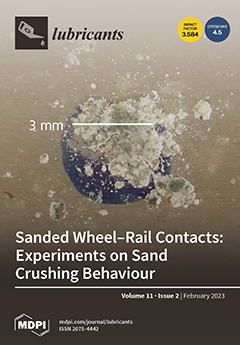Lubricants are essential to machinery life, as they play a crucial role in controlling and diminishing the friction and wear between moving parts when operated under extreme conditions. To this end, due to tight environmental conditions, manufacturers are looking for alternative solid lubricants
[...] Read more.
Lubricants are essential to machinery life, as they play a crucial role in controlling and diminishing the friction and wear between moving parts when operated under extreme conditions. To this end, due to tight environmental conditions, manufacturers are looking for alternative solid lubricants to be dispersed in base liquid lubricants. MoS
2 and graphene are solid lubricants that provide low frictional properties and high thermal stability in both oxidizing and non-oxidizing environments. This research offers a new lubricant with improved thermal conductivity that combines the synergistic effect of graphene and MoS
2 in a blend of vegetable oil (peanut) and naphthenic oil. The ratio of peanut oil and naphthenic oil varies from 1:3–3:1. A fixed composition of 4.34 wt.% palm oil methyl ester (POME) is added to enhance the anti-wear property further. Graphene and MoS
2 concentrations varied between 1:2–5:2, respectively. This nanoparticle additive oil blend is physically mixed using a water bath sonication for 4 h. The stability of the blend lubricant dispersed with MoS
2 and graphene is studied using a UV-Vis spectrophotometer for 25 days. The effect of various concentrations of graphene, MoS
2, peanut oil, and naphthenic oil on the thermal conductivity of the nanolubricant is also studied as a function of temperature (25 °C–55 °C). Artificial neural network models were used for the parametric investigation of the nanolubricant. It is found that the stability of the formulated nanolubricant increased with peanut oil composition above 25 wt.%. The results show that the 3:1 blend ratio showed higher stability for hybrid MoS
2-based lubricants. Similarly, the highest thermal conductivity is observed for 100 wt.% naphthenic oil with a 1:2 ratio of graphene–MoS
2 at 55 °C.
Full article





